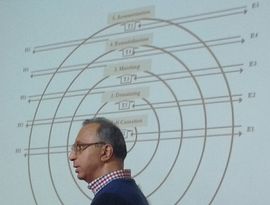Half-Causation debunks the deep-seated myth that coming up with inventive concepts is mysterious and cannot be systemised. On the surface inventing does appear to be mysterious and is occasionally helped by idiosyncrasies and coincidences. However, all such surface events are only tokens, which ultimately lead the inventor to some underlying new relation between types. Now, a relation between types can be reached in a perfectly systematic manner, without having to wait for chance surface events to guide the invention process. This is what the Half-Causation Method is about.
The Method is named after its first phase, which consists of the methodological idealisation of the causal process, by pinpointing half of a possible causal relation while ignoring everything else. Following this, the Method prescribes how the reasoning should proceed, which ultimately constructs a complete and novel causal process. The Method is discipline-neutral and suits any research outcome which is in principle patentable, from mechanical engineering to pharmaceuticals. It is intended to be implemented by scientists and engineers, individually or in teams, using their disciplinary knowledge and expertise.
Details of Half-Causation are presented in the following papers:
Abolkheir, Mo. 2021: ‘How Half-Causation can enlighten the drafting of patent claims’. Queen Mary Journal of Intellectual Property.
Volume: 11 Issue: 4 Pages:469–483. This paper is accessible via the following link:
https://doi.org/10.4337/qmjip.2021.04.03
Abolkheir, Mo. 2019: “If You Wish to Invent Then Follow the Half-Causation Method.” Techné: Research in Philosophy and Technology
23(1): 26–50. This paper is accessible via the following link:
http://dx.doi.org/10.5840/techne201951194
Training & Consultancy: Limited services are available. Please email any enquiries to:
